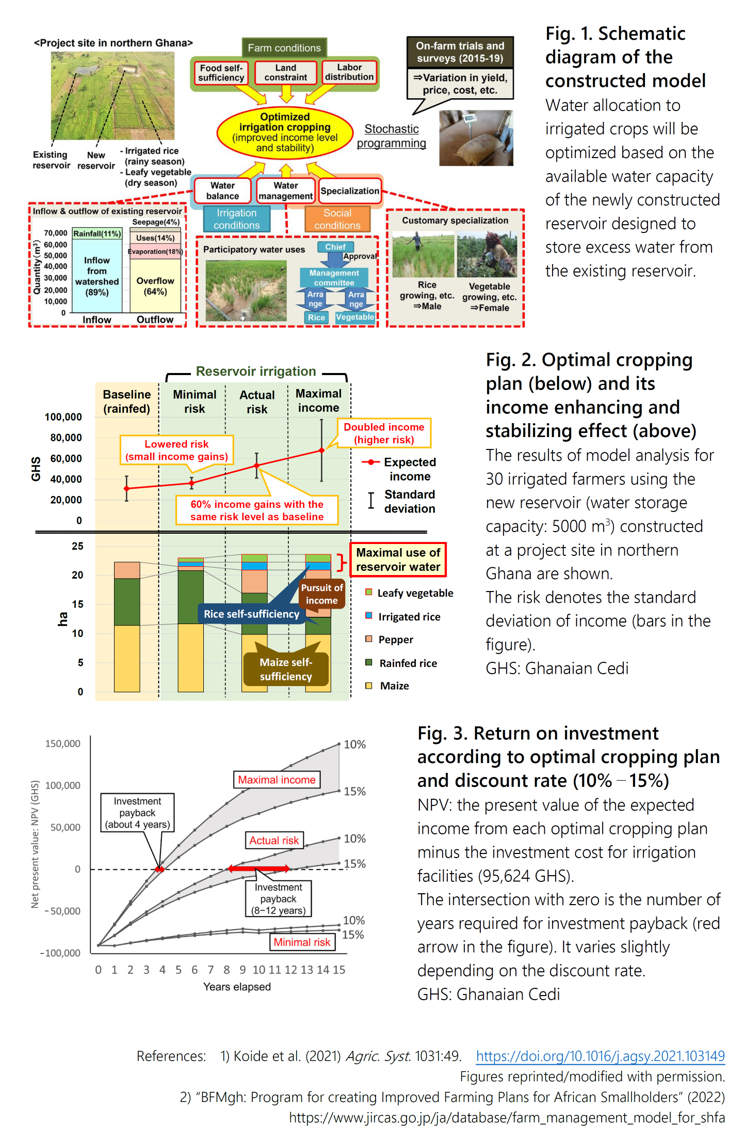Mitigating income stagnation and volatility in African smallholder agriculture using small reservoir irrigation technology and stochastic programming model
Description
Due to the precarious nature of rainfed crop production, smallholder farmers in Africa are confronted with the peril of insufficient and unstable income (hereinafter referred to as "risk"). While irrigation has been recognized as a means of mitigating this risk, irrigation plans that are well-suited for farmers' risk management are seldom explored. This study introduces a farm management planning model that integrates the production of irrigated crops utilizing a small reservoir with that of rainfed crops. This model is based on the results of a participatory on-farm trial and survey conducted over a five-year period in northern Ghana. Using stochastic programming, the model considers the variability of crop yields, prices, and costs under the prevailing farm, water, and social conditions in order to identify the most effective irrigation cropping patterns that enhance and stabilize income (Fig. 1).
The model analysis revealed three distinct types of optimal cropping based on the level of risk and income: minimal risk, actual risk, and maximal income. To minimize risk, pepper production, which is highly profitable but risky, should be reduced, and rice and leafy vegetables should be grown instead, using a small reservoir. If farmers can tolerate the actual level of risk in rainfed agriculture, it is suggested that they decrease maize production, the primary staple, to a self-sufficient level and expand irrigated rice and leafy vegetable production, which could result in a 60% increase in expected income. Reducing rainfed rice production to a level that enables rice self-sufficiency and increasing pepper production will maximize expected income. Although risk will increase, the income level is expected to exceed that of rainfed agriculture even in the case of a downturn in income (Fig. 2). Note that the investment in irrigation facilities is difficult to recoup in the "minimal risk type" due to the limited increase in expected income. The "maximal income type" can recoup its investment in approximately four years, while the "actual risk type" can do so in approximately eight to twelve years (Fig. 3).
To facilitate the improvement of local cropping systems, a program called BFMgh has been developed to create enhanced farming plans for smallholders in Ghana. The program stores sample data on irrigated and rainfed crops collected during this study and is available on the JIRCAS website. In northern Ghana, attention should be given to potential conflicts over reservoir water usage as some individuals may seek to utilize a portion of the reservoir water for domestic purposes, even if it was constructed for agricultural purposes.
Figure, table
- Research project
- Program name
- Term of research
-
FY2015–2022
- Responsible researcher
-
Koide Junji ( Social Sciences Division )
ORCID ID0000-0003-1726-4400Yokoyama Shigeki ( Research Planning and Partnership Division )
Hirouchi Shinji ( Rural Development Division )
MIERUKA ID: 001783Oka Naoko ( Rural Development Division )
MIERUKA ID: 001802Hirose Chikako ( Former Rural Development Division )
MIERUKA ID: 001803Yanagihara Seiji ( Biological Resources and Post-harvest Division )
MIERUKA ID: 001780Oda Masato ( Former Crop, Livestock and Environment Division )
ORCID ID0000-0001-7241-5238Oishi Wataru ( University of Tsukuba )
- ほか
- Publication, etc.
-
https://doi.org/10.1016/j.agsy.2021.103149
Koide et al. (2021) Agricultural Systems 191:103149.
Programs for creating Improved Farming Plans for African Smallholders (2022) https://www.jircas.go.jp/ja/database/farm_management_model_for_shfa - Japanese PDF
-
2022_B10_ja.pdf3.25 MB
- English PDF
-
2022_B10_en.pdf894.66 KB
* Affiliation at the time of implementation of the study.

